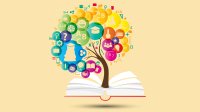The Neuroscience of Narrative and Memory
Delivering content—in any class—through a story has positive effects on your students’ information retention.
If you’ve had the pleasure of reading bedtime books to young children, you’ve observed one of the reasons why narratives are so compelling. During their childhood, my daughters wanted to hear the same book, Goodnight Moon, over and over: Even after dozens of readings, they continued to excitedly predict what would be on the next page and to take great pleasure in being right.
That childhood desire of children—wanting to hear books read aloud and repeatedly requesting those few they know well enough to predict—encompasses powerful brain drives that become memory enhancers.
The experiences we have with narratives starting as young children establish supportive conditions in the brain for learning and remembering, based on a foundation of emotional connections to the experience of being read to or told stories. In addition, the familiarity of the narrative pattern becomes a strong memory-holding template.
Positive Emotions
Listening to stories during childhood is a pleasurable experience that the brain remembers and continues to seek throughout life. Strong emotional memory connections are intrinsic to children’s experiences of being read to or told stories. Often the memory is simply the cozy feeling of being snuggled in bed. Notably, though, even for children raised in tumultuous circumstances, memories of bedtime stories mean that things were relatively, or at least temporarily, calm.
Far beyond childhood, when one recalls being read to or told a story, there is a renewal of the sense of being cared for. That positive emotional state can resurface throughout one’s life when narratives are heard.
In addition, hearing the same book repeatedly allows the brain to seek its own intrinsic rewards. The brain’s response to making a choice or prediction that turns out to be correct is a release of dopamine, triggering a feeling of deep satisfaction and pleasure.
This dopamine-reward response is particularly generous in young children. Although it soon evolves to responding to real predictions—choices or answers that are not known for sure—during the bedtime story years, this prediction-reward response is activated even when the child knows with great certainty what is on the next page.
Frameworks for Memory Construction
As stories from childhood are linked to positive emotional experiences, they provide an insight into the patterning system by which memories are stored. Our brains seek and store memories based on patterns (repeated relationships between ideas). This system facilitates our interpreting the world—and all the new information we find throughout each day—based on prior experiences.
The four-step structure of narrative—beginning (Once upon a time...), problem, resolution, and ending (...and they all lived happily ever after)—forms a mental map onto which new information can be laid.
When that new information, whether from algebra or history, is presented in the familiar narrative form, the memory structure facilitates the brain’s retention of that information. With time that map expands to include narratives in which the ending is not “and they all lived happily ever after” but rather an opportunity for the student to explore or discover possible outcomes.
Sample Narratives for the Classroom
Algebra: “Maria did her chores all week and loved waking up on Saturday and getting her allowance. When she turned 13, her parents offered her a choice. She could change to a monthly allowance of $100, or have the amount of money accumulated in a month if she started with 1 penny on day one that was doubled each day for the 30 days. Excited to get a sum as large as $100, Maria chose that. What would you choose?”
After students have a chance to make their choices and see the surprising result of the doubling—a payment of $5,368,709.12—they are ready to follow the narrative into exponents.
Science: “There was a guy, call him Archie, who wanted to know why the level of water in his bathtub rose so that it sometimes overflowed when he got into the tub. It’s said that he tried lots of experiments that didn’t work, but one day he figured it out and said, ‘Eureka!’”
You can use the story of Archimedes to offer students the same challenge—figure out why the water level in a cup goes up when they place a coin on a poker chip floating in the water and then down when they drop the coin to the bottom.
History: “We love to celebrate advances in flying machines, including spaceships. But sometimes something happens to make everyone worry about the safety of those on the craft.”
Use primary news sources to explore with students the beginning and middle of stories like the Hindenburg disaster or the flight of Apollo 13. Look at news reports about rigid airships or the space program and about how each trip was covered up to the point when things started to go wrong. Then ask for predictions about how things turned out, before going on to reveal the end of each story.
Weaving learning into a story makes learning more interesting, activates the brain’s positive emotional state, and hooks the information into a strong memory template. The memory then becomes more durable as the learning follows the narrative pattern through sequences connected to a theme, time flow, or actions directed toward solving a problem or reaching a known goal.
